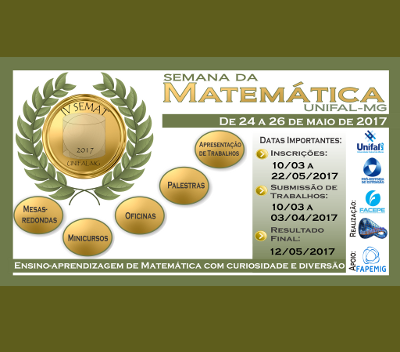Applications of Algebraic Structures in the Connection between Standard and Genetic Communication Systems
Keywords:
Genetic Code, Galois extensions, models of communication, AnalogiesAbstract
One of the big challenges for the scientific community is to analyze the existence of a mathematical structure related to DNA and a communication system. This article aims to identify the application of algebraic structures in the connection between the central dogmas of communications theory and molecular biology. By considering the outlined aim, it was necessary a previous knowledge of cellular and molecular biology, as well as concepts of abstract algebra and communication systems, for the algebraic association with the genetic code in a communication system. In this study, it was analyzed the models of genetic communication systems proposed by Gatlin (1972), May et al. (2004), Rocha and Palazzo J ́unior (2010) and Faria and Palazzo Junior (2011). Through this association, one can perceive, an interesting connection between biological elements (genetic code), engineering (signals constellation in an information transmission process) and elements of algebra (Galois extension GF (GF(2)^6). The results presented in this paper contribute to an area of research that is expanding, making biology become a science theoretically based on mathematical concepts.
References
ALBERTS, B. et al. Biologia Molecular da Célula. 5. ed. Porto Alegre: Artmed, 2010.
BATTAIL, G. An Outline of Informational Genetics. Morgan e Claypool Publishers, 2008.
DOMINGUES, H. H.; IEZZI, G. Álgebra Moderna. 4. ed. São Paulo: Atual, 2003.
FARIA, L. C. B.; PALAZZO JÚNIOR, R. Existências de Códigos Corretores de Erros e Protocolos de Comunicação em Sequências de DNA. 2011. 147 f. Tese (Doutorado em Engenharia Elétrica) - Faculdade de Engenharia Elétrica e de Computação Universidade Estadual de Campinas (Unicamp), Campinas, 2011.
GARCIA, A.; LEQUAIN, Y. Elementos de álgebra. 5. ed. Rio de Janeiro: IMPA, 2010.
GATLIN, L. L. I. Information Theory and the Living System. Columbia University Press, New York, NY, 1972.
GONÇALVES, A. Introdução à álgebra. Projeto Euclides, 5. ed. Rio de Janeiro: IMPA, 2009.
LIN, S.; COSTELO JR, D. J. Error Control Coding: Fundamentals and Applications. Englewood Clisffs: Prentice Hall, 1983.
MAY, E. E. Towards a Biological Coding Theory Discipline. Review New Thesis, v.1, n.1, p. 19-38, 2004.
MAY, et al. An error-correcting code framework for genetic sequence analysis. Journal of The Franklin Institute, v.341, n.23, p.89-109, 2004.
OLIVEIRA, A. J.; PALLAZO JÚNIOR, R. Análise Algébrica dos Rotulamentos Associados ao Mapeamento do Código Genético. 2012. 105 f. Dissertação (Mestrado em Engenharia Elétrica) - Faculdade de Engenharia Elétrica e de Computação Universidade Estadual de Campinas (Unicamp), Campinas, 2012.
PAMPHILE, J. A. (Org.), VICENTINI, V. E. P. (Org.). Genética. Maringá: EDUEM, 2011.
ROCHA, A. S. L., PALAZZO JÚNIOR, R., SILVA-FILHO, M.C. Modelo de sistema de comunicações digital para o mecanismo de importação de proteínas mitocondriais através de códigos corretores de erros. 2010. 155 f. Tese (Doutorado em Engenharia Elétrica) - Faculdade de Engenharia Elétrica e de Computação Universidade Estadual de Campinas (Unicamp), Campinas, 2010.
SHANNON, C. E.; A mathematical theory of communication. The Bell System Technical Journal, v.27, p. 379-423, 1948.
Downloads
Additional Files
Published
How to Cite
Issue
Section
License
Proposta de Política para Periódicos de Acesso Livre
Autores que publicam nesta revista concordam com os seguintes termos:
- Autores mantém os direitos autorais e concedem à revista o direito de primeira publicação, com o trabalho simultaneamente licenciado sob a Licença Creative Commons Attribution que permite o compartilhamento do trabalho com reconhecimento da autoria e publicação inicial nesta revista.
- Autores têm autorização para assumir contratos adicionais separadamente, para distribuição não-exclusiva da versão do trabalho publicada nesta revista (ex.: publicar em repositório institucional ou como capítulo de livro), com reconhecimento de autoria e publicação inicial nesta revista.
- Autores têm permissão e são estimulados a publicar e distribuir seu trabalho online (ex.: em repositórios institucionais ou na sua página pessoal) a qualquer ponto antes ou durante o processo editorial, já que isso pode gerar alterações produtivas, bem como aumentar o impacto e a citação do trabalho publicado (Veja O Efeito do Acesso Livre).

